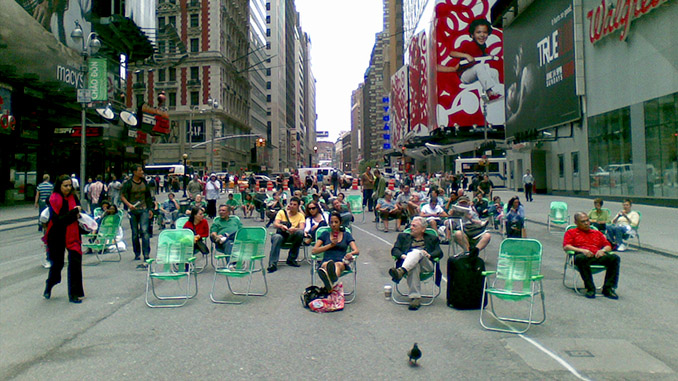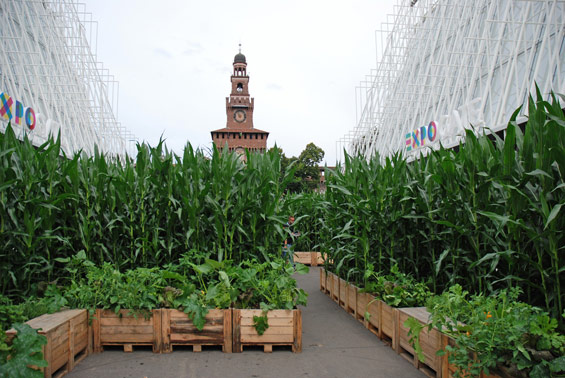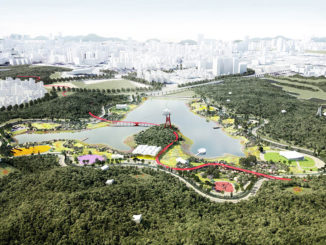Over the last two decades, we have seen the popularity of pop-ups grow within cities from retail stores to parklets. Pop-ups fall into various typologies from the short event (1-3 days) such as Parking Day, seasonal installation, semi-permanent installation such as pilot study for possible retrofitting a street. Are these pop-ups transforming cities and attitudes towards public space or are they little more than brightly coloured interventions that are becoming the “fast-food” of landscape architecture?

Popups have been used successfully for testing ideas in New York, Melbourne, Philadelphia, such as full or partial road closures. These popups used simple materials such as lounges, trees planters, packaging crates/palettes and other reusable materials to test the way people would interact with space and also how the surrounding areas were impacted.

However, in recent years we have seen many pop-ups that have been installed across the world that could be classified as “fast-food popup” by using brightly coloured highly designed structures that use raw materials (virgin timber, synthetic grass, etc) with a short-term use. These fast-food pop-ups often highly commercial in nature with little thought given to the lifecycle of materials used and the energy and resources used and the ultimate end disposal of the pop-up. It appears the aim of these fast-food popups is more about participating in an event (promoting a product) and creating a fun space, rather than addressing a problem or providing a pilot/test for communities and cities. The question has to be asked what are these pop-ups achieving and how will the community benefit once they are gone.
Public space popups were previously free, unbranded installations that we simple in their idea and simple in execution, now they have morphed into highly branded with bars and cafes(i.e. not free) and are overly complicated in their design but very low on ideas. They have in recent times have been selected by cities and designers as the easy way out for a design solution as they are fashionable, politically agreeable and seen to address a problem. Where in fact, the city and designers need to face up to the facts that the problem is larger and harder than they are willing to admit and a pop-up is a testing an idea and has a limited lifespan. Too many pop-ups have morphed into whimsical designs that may be socially sustainable for a short period but environmentally unsustainable in the long term.
Fast-food pop-ups have also permeated into environmental events such as Parking Day with highly constructed designs using one-use materials to create a pop-up for 6-8 hours. Shouldn’t these events be more about picking a site (or cause) that could possibly become a permanent converted space for the community rather than design firms and design schools having a fun event to post on social media?
How as designers can we make popups make a difference? To do this we need to use ask ourselves the following questions:
- What problem are we trying to solve? What are we trying to achieve?
- Are we trying to convince keystone holders (community, council or other) that this could become a permanent change or is it seasonal?
- How can we get more people involved?
- How long will it be a pop-up?
- What is materials will be used to build it?
- What materials and resources will it consume? (could they be better spent elsewhere?)
- What to do with the pop-up after the event?
- Is it semi-permanent or transportable pop-up? Is it modular and easy to pull apart so it can be easily transported for testing the idea elsewhere?
- How do we evaluate the idea the popup is testing?
Schools can use pop-ups as a teaching tool in design degrees for students to learn concept, development, construction, evaluation, and lifecycle. Through this type of project, students can apply all their learnings in the real world. All too often students and employers complain that new graduates lack the understanding of how to apply the knowledge they have learned and pop-ups can provide multi-discipline learning opportunities through a low-cost small-scale group project.
Pop-ups offer designers and cities the opportunity for transforming more than space but also people’s attitudes towards the use of streets and public spaces. They require more lateral thinking about the intent and outcome that will be achieved. The most successful pop-ups are those that are built with a sound idea, involve community groups and utilise sustainability principles, including the use of reclaimed and reusable materials, utilise non-mechanical construction techniques (more traditional carpentry) and they are modular (for ease of assembly and movement.
A pop-up doesn’t need to be a one-off centrepiece for an event, it can continue its life by being transported to different events or remodeled or reused to create a new popup (this is the importance of modular construction) in a different location or for a different purpose or season. As landscape architects, we receive requests to design pop-ups we need to ask ourselves is this fast food popup or a possible catalyst for change?
Editorial Written by Damian Holmes is the Founder and Editor of WLA.
He is also a registered Landscape Architect and has over 17 years experience as a landscape architect in Australia, Canada and China.
Times Square Image Credit | andresmh
Milan Expo Image Credit | Francesco Gusella



